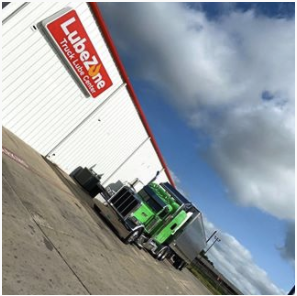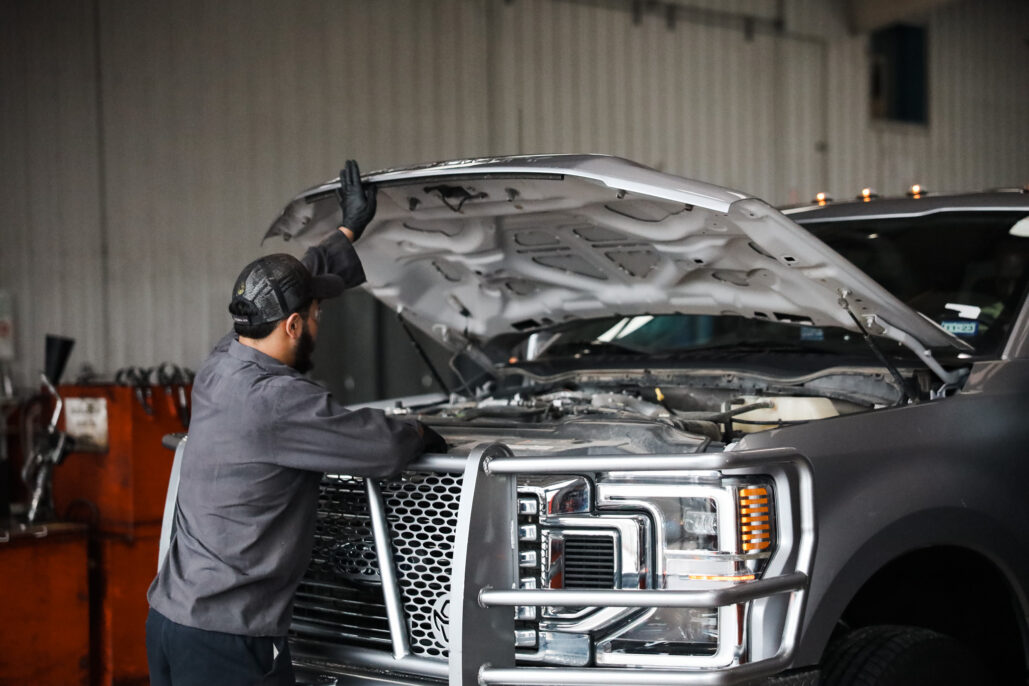
Optimizing Diesel Fuel Efficiency: A Comprehensive Guide
October 7, 2025
What Happens If You Fail a DOT Inspection?
October 14, 2025As a long-haul trucker, you’re so much more than a driver. At times, you’re also a maintenance provider, making sure that your rig stays in prime operating condition. You’re expected to troubleshoot minor issues and get attention for larger issues promptly to stay on the road and meet your deadlines. Knowing the best roadside maintenance hacks is absolutely key.
When you haul freight hundreds of miles across a highway, the last thing you want is a breakdown. That eats into your time and money. That’s why every trucker needs to be equipped with a few go-to emergency truck maintenance tips and equipment to stay safe, save time, and keep moving.
From quick roadside maintenance hacks to a fully stocked emergency truck repair kit, being prepared isn’t just smart — it’s essential. Why pull over at a service station, wait in line, and pay maintenance fees for something you can handle in the parking lot? At LubeZone Truck Lube Centers, we know that time is money.
That’s why we’re sharing expert-backed advice designed for long-haul drivers who want to handle minor route hiccups confidently. Whether you’re facing a blown fuse, a coolant leak, or a flat tire in the middle of nowhere, this guide has you covered with practical fixes and smart planning strategies.
Keep reading to get the best roadside maintenance hacks for semi-trucks as well as tips to create the perfect emergency truck repair kit to keep by your side for all your hauls.
Roadside Maintenance Can Save Your Haul
When hauling valuable cargo across state lines, a breakdown isn’t just inconvenient — it’s costly. Roadside maintenance isn’t just about making do. It’s about protecting your schedule, load, and bottom line.
That’s why assembling an emergency truck repair kit should be at the top of every long-haul driver’s pre-trip checklist. The reality is that a minor breakdown is bound to happen sooner or later. But when you have the right tools, you can get back on the road quickly. Don’t let a 45-minute pitstop turn into a four-hour waiting game by calling roadside assistance when you can have all the tools you need easily within your reach.
The Cost of Getting Stranded
Every minute stuck on the shoulder raises costs for long-haul drivers and owner-operators. From missed delivery windows to added fuel consumption during idle time, delays can quickly eat into your paycheck.
Here’s what a single breakdown might cost you:
- Towing fees: $500–$2,000.
- Lost revenue: Up to $760/day from delivery setbacks (Red Arrow Logistics).
- Load penalties: Late arrival fines or lost contracts.
- Repairs: Higher emergency rates vs. preventative fixes.
- Stress and safety risks: Especially when stranded on high-speed highways.
Performing basic emergency truck maintenance can help you avoid these expenses and stay in control of your route.
Staying Safe and Compliant
For long-haul truckers, staying DOT-compliant is key. The last thing you want is for the department to take your OOS or issue a fine due to basic oversights.
Keep these safety tips in mind when working on your semi-truck:
- Pull off in a safe, visible location.
- Use reflective triangles and hazard lights.
- Wear a high-visibility safety vest.
- Chock your wheels before working.
- Never bypass a safety-related fix to keep driving.
Fixes for Fluids and Filters
Fluids are the lifeblood of your rig. From coolant to oil, even a minor leak or low level can spiral into a full-blown mechanical failure if you don’t address it quickly. Pay close attention to your truck’s dashboard warning lights while en route to make simple fixes quickly.
When you need a quick and reliable oil change on the road, head on over to the closest LubeZone Truck Lube Center. We’re home to the famous 40-minute oil change, with no appointment necessary.
Common Fluid Issues and What to Carry
Some of the most common minor fluid issues in semi-trucks include:
- Low engine oil levels from extended miles without a top-off.
- Coolant loss due to small leaks in hoses or connections.
- Brake fluid evaporation or minor leaks from worn seals.
- Power steering fluid seepage that causes stiffness at the wheel.
- Fuel system air locks or contamination from poor-quality diesel.
- Windshield washer fluid depletion in dusty or icy conditions.
Here’s what to keep on board to avoid costly setbacks:
- Oil
- Coolant
- Brake Fluid
- Power Steering Fluid
- Fuel Treatment
- Windshield Washer Fluid
Identifying Oil, Coolant, and Fuel Problems
Fluid leaks leave clues, and a trained eye (and nose) can quickly narrow them down, helping to avoid further issues.
Here’s how to identify common fluid problems:
Engine Oil
- Look for: Dark brown or black puddles under the engine.
- Feel: Thick, greasy texture.
- Smell: Burnt or metallic odor.
- Fix tip: Check the dipstick. If it’s low or dirty, top off and schedule an oil change soon. Ask LubeZone to conduct a full oil analysis to better understand what’s happening with your engine.
Coolant (Antifreeze)
- Look for: Bright green, orange, or pink fluid under the front end.
- Feel: Slick, watery, slightly sticky.
- Smell: Sweet, syrupy scent.
- Fix tip: Top off only when the engine is cool. If the reservoir drains again quickly, you’ve likely got a leak.
Diesel Fuel
- Look for: Clear to yellowish fluid with a sheen under fuel tanks or lines.
- Feel: Thin, very slick.
- Smell: Strong fuel odor.
- Fix tip: Tighten the fuel cap or check for cracked fuel lines. Fuel additives can help reduce contamination while en route to a service stop.
Power Steering Fluid
- Look for: Reddish or amber leaks near the front suspension.
- Feel: Lighter than engine oil, slick.
- Smell: Slightly burnt or mechanical.
- Fix tip: Check the reservoir. Steering stiffness is a warning sign that you’re running low.
When to Head to a Service Stop
Not every fluid issue can, or should, be handled on the roadside. Temporary fixes have their limits, and pushing your truck too far with an unresolved leak or warning light can lead to major mechanical failure.
Here’s when it’s time to head to a service shop:
- You’re topping off the same fluid more than once in a short period.
- You can’t identify where a leak is coming from.
- There’s visible smoke, steam, or a strong burnt odor.
- Dashboard warning lights stay on or come back after resets.
- Your engine temperature is spiking abnormally.
- You notice reduced braking power or steering responsiveness.
- There’s contamination in the fluid (milky, cloudy, or gritty appearance).
Tire Troubles on the Highway
Tires are one of the most frequent sources of roadside issues for long-haul truckers. Blowouts, punctures, and uneven wear can throw off your schedule or create dangerous driving conditions. Fortunately, fast roadside maintenance hacks can get you rolling again if you know what to look for and when to call for backup.
Spot Fixes vs. Roadside Help
You can make some simple tire repairs on the spot. However, there are some problems that you’ll need to address with roadside service. Knowing the difference helps you make a call that’s safest, most time-efficient, and least expensive.
You can likely handle it yourself if:
- You have a slow leak from a nail or small puncture.
- The tread is still intact, and the sidewall isn’t damaged.
- You carry a tire plug kit and a portable air compressor.
- The tire pressure is low but holding after re-inflation.
- You’re experienced and parked in a safe location.
Call for help or pull into a service center if:
- You experience a blowout or full deflation at speed.
- There’s bulging, cracking, or sidewall separation.
- The tire has cords or steel belts exposed.
- You’re carrying an oversized or specialized load.
- You’re in a dangerous or poorly lit area.
Quick Electrical and Lighting Repairs
Lighting and electrical issues might seem minor, but they can lead to DOT violations, fines, or even accidents if left unresolved. Luckily, many of these problems are easy to diagnose and fix on the fly.
Tools You Need in Your Cab
A well-prepped emergency truck repair kit should include basic electrical tools. These can help you troubleshoot blown fuses, loose connections, or malfunctioning lights without a trip to the shop.
Essential electrical tools and supplies to carry:
- Digital Multimeter
- Spare Fuses and Relays
- Wire Cutters and Strippers
- Crimp Connectors and Electrical Tape
- Battery Terminal Cleaner and Brush
- 12V Test Light
- Extra Bulbs
Tests to Diagnose Power Issues
Electrical issues can seem tricky, but a few simple tests can point you in the right direction fast:
- No power to lights? Check the fuse box first. Replace any blown fuses with matching amps.
- Lights flickering? Look for a loose ground wire or corroded terminal.
- Cab power issues? Test the battery voltage (12.4V–12.7V when parked is ideal).
- Accessory failure? Use a multimeter to confirm that the voltage is reaching the connection point.
- Dash lights or sensors flickering? Inspect alternator output and wiring harnesses.
There’s likely a deeper issue if you’re consistently losing power or replacing fuses. In those cases, it’s best to seek professional assistance.
Emergency AC Repairs on the Road
Sometimes, you might find yourself hauling it through triple-digit temps — the deserts of Arizona, the coastline of South Florida, or the dry roads of Texas. One thing is sure – it can get HOT. If your AC system isn’t working, it’s not only uncomfortable but also potentially dangerous.
Recognize the early signs of AC trouble and know a few fast fixes to restore cabin cooling when it matters most. Be sure to get regular AC tune-ups for your preventative maintenance.
Signs Your Truck’s AC Is About to Fail
If any of these symptoms pop up, your AC system is likely losing refrigerant, dealing with a failing compressor, or facing an electrical problem:
- Weak or inconsistent airflow from vents.
- Unusual noises like rattling or clicking occur when the AC is on.
- Warm air is blowing despite the system being set to cold.
- Strange smells, often moldy or musty.
- Cabin humidity, even when the AC is running.
- The AC clutch does not engage when the system turns on.
Quick Hacks for Restoring Cabin Cooling
While AC systems usually need shop-level tools for full repair, you can take steps to stay cool or restore function temporarily on the road:
- Check your cabin air filter.
- Inspect AC fuses and relays.
- Use a rechargeable can.
- Park smart, using reflective dash shields and window visors.
- Keep cooling towels or portable fans in your emergency kit to stay safe in high-heat conditions.
Air System Failures
Your truck’s air system controls two critical functions: braking and suspension. When air pressure drops unexpectedly or lines fail, it can be dangerous and costly, especially if you’re miles from a service center.
Common Air Brake and Suspension Issues
Air systems are tough, but not invincible. Here are some of the most common failures drivers experience on long hauls:
- Air Leaks
- Compressor Failure
- Frozen Air Lines
- Faulty Pressure Sensors
- Slack Adjuster Problems
- Suspension Bags Deflating
How to Stabilize Air Pressure Until You Reach a Shop
Most air system issues do require professional maintenance to restore proper function. However, you can stabilize the system until you reach a service center.
- Drain air tanks daily to prevent moisture buildup and freezing.
- Apply air line antifreeze in extreme cold to clear frozen valves or lines.
- Use soap spray to locate slow leaks at fittings and connectors.
- Tighten connections gently if you spot a minor leak at a fitting.
- Idle your truck in short bursts to help the compressor rebuild pressure.
- Avoid heavy braking if you’re seeing pressure drops and coast when possible.
Greasing on the Go
Grease might not seem like a big deal–until your U-joints or fifth wheel start grinding halfway through a haul. Lubrication failures can lead to breakdowns, steering issues, and even safety risks. Keeping key components greased is a simple but often overlooked emergency truck maintenance move that can save you big when you’re far from a shop.
When a Portable Grease Gun Isn’t Enough
A portable grease gun is a great addition to your emergency truck repair kit, but it’s not a cure-all. There are limits to what you can do roadside:
- Heavily worn joints may not accept grease if seals are already compromised.
- Frozen zerks or damaged fittings can prevent proper flow.
- Missed maintenance intervals mean grease can’t reverse the damage.
- Fifth-wheel plates with baked-on grime may need a full cleaning before reapplication.
How Preventive Greasing Pays Off in Emergencies
The best roadside maintenance hack is not needing one. Keeping your truck properly greased during routine service intervals helps you avoid the following:
- Driveline vibration from dry U-joints.
- Premature suspension wear.
- Steering stiffness or lag.
- Fifth-wheel binding that makes trailer handling unsafe.
- Component failure under stress, especially in high-heat or high-load hauls.
At LubeZone Truck Lube Center, we offer tractor and trailer grease services with every maintenance option.
Stop at LubeZone Truck Lube Center for Preventative Maintenance Near You Today
Now that you know what to do if your semi-truck breaks down and what items to have in your emergency truck repair kit to prevent minor inconveniences from turning into large emergencies, it’s time to get rolling.
Stop at the closest LubeZone Truck Lube Center along your next route for a full range of preventative maintenance, like quick oil changes, free tire checks, and DOT inspections. With our list of roadside maintenance hacks, you can stay on the offensive to keep your truck running smoothly.

LubeZone is the fastest growing dedicated semi-truck service in the United States with locations in Texas, California, Oklahoma, North Carolina and Georgia. Our preventative maintenance solutions are designed to get the professional driver back on the road FAST.



